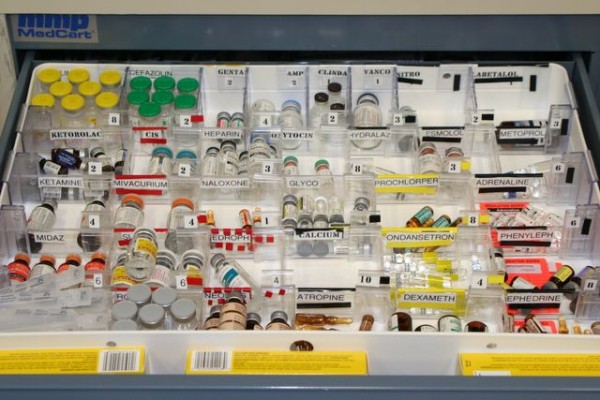Medication trays – a.k.a. med trays, code trays/kits/boxes/bags, transport trays/kits/boxes/bags, intubation kits, C-section trays, anesthesia trays, and so on ad infinitum – are common in acute care pharmacies.  I’ve seen them in every variation you can imagine in every pharmacy I’ve ever been in.
Depending on the situation, med trays can contain a large number of injectable medications. For example: code trays may contain several different neuromuscular blockers like vecuronium, rocuronium, succinylcholine; pressors like epinephrine, norepinephrine, phenylephrine;  other code drugs like atropine, vasopressin; reversal agents like naloxone and neostigmine; antibiotics, etc, while a C-section tray may contain local anesthetics in various shapes and sizes (lidocaine with or without EPI, SDV or MDV, bupivacaine of various concentrations, etc). The list goes on. It’s pretty crazy.

Busy hospitals may have more than a hundred trays floating around the facility at any given time with another 30-50 sitting in the pharmacy waiting to be filled by a technician, checked by a pharmacist, or in need of delivery; of course the number of trays will be smaller for smaller facilities. In hospitals with busy Emergency Departments and/or busy OR’s that use anesthesia trays, the turnover rate is rather impressive.  Use…fill…check…deliver, done repeatedly throughout the day.
I don’t know how many trays I’ve checked during my nearly 18-year career, but I’m sure it’s in the thousands.(1)
Recently I’ve had more than ample time to reflect on the process – read that as I’ve recently had to check a lot of med trays. Spending all that time looking at med trays has given me time to think a little more deeply about the process.
- Med trays are prone to error. It’s a manual process and everyone is always in a hurry.(2)  I’ve found my fair share of errors while checking trays. The most common type of error is omission of a drug, either failure to fill and empty slot or failure to bring the quantity up to the required par. Another type of error I see is when something has been used, placed back in the tray by the physician or nurse, and not replaced by the technician. In other words I find a partial vial in the tray. I also occasionally find the wrong drug in the tray. It’s rare, but it happens. I almost never find drugs mixed up in pockets, or placed in the wrong pocket.  I find this interesting. One has to wonder why pharmacies continue to use such an antiquated process.  If you must use med trays, there are bar-code scanning and RFID-enabled tray management systems on the market. I recommend you get one. Which one is up to you.
- Med trays are dirty. Does anyone besides me wonder if these things pose an infection risk? Think about how many times an anesthesia tray gets used over the course of its lifetime. As much trouble as we go through in the IV room to prevent contamination, one would think we’d do something to ensure the sterility of med trays. Wipe them down with alcohol? Blast them with UV light? Something. These things are being used in ORs where everything is supposed to be sterile. Many years ago a colleague and I wanted to do a study on anesthesia trays. We proposed performing swab tests on the trays when they were returned to pharmacy for replenishment. We were trying to be covert about it, but the pharmacy manager and infection control department got wind of what we were doing and shut us down. They didn’t want to know. No regulatory body required it so they wanted nothing to do with it. I tried to convince them that it could be publishable, but they didn’t want to hear it.
- Tray color matters. I know this sounds weird, but dark colored trays make it more difficult to read the labels on the vials. I hadn’t noticed the problem until recently. I had been checking trays that were dark blue, and then I came across a yellow tray. Man, what a difference. Maybe it’s my aging eyes, but something to think about.
—————–
1. There were times during my career when I checked 20-40 trays a day for long stretches, so it’s not hard to imagine that I averaged more than 20 trays a week for the better part of 10 years.
2. To properly check a med tray, a pharmacist needs to verify that the drug is correct, in tact, and in the right location; that the drug is not expired; and that it has all the required auxiliary labels to meet the never ending onslaught of regulatory requirements. When done correctly, each tray takes approximately 3-5 minutes to check. Assuming 40 trays at 5 minutes each, a pharmacist would need to spend more than 3 hours of their 10 hour shift doing nothing but checking med trays. Not likely. A more likely scenario, of which I’m guilty of, is giving the tray a quick once over. How many errors have I missed over the course of my career? Too many to count, I’m sure.
Leave a Reply